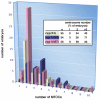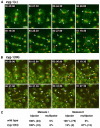Control of mitotic and meiotic centriole duplication by the Plk4-related kinase ZYG-1
- PMID: 20144993
- PMCID: PMC2823580
- DOI: 10.1242/jcs.050682
Control of mitotic and meiotic centriole duplication by the Plk4-related kinase ZYG-1
Abstract
Centriole duplication is of crucial importance during both mitotic and male meiotic divisions, but it is currently not known whether this process is regulated differently during the two modes of division. In Caenorhabditis elegans, the kinase ZYG-1 plays an essential role in both mitotic and meiotic centriole duplication. We have found that the C-terminus of ZYG-1 is necessary and sufficient for targeting to centrosomes and is important for differentiating mitotic and meiotic centriole duplication. Small truncations of the C-terminus dramatically lower the level of ZYG-1 at mitotic centrosomes but have little effect on the level of ZYG-1 at meiotic centrosomes. Interestingly, truncation of ZYG-1 blocks centrosome duplication in the mitotic cycle but leads to centrosome amplification in the meiotic cycle. Meiotic centriole amplification appears to result from the overduplication of centrioles during meiosis I and leads to the formation of multipolar meiosis II spindles. The extra centrioles also disrupt spermatogenesis by inducing the formation of supernumerary fertilization-competent spermatids that contain abnormal numbers of chromosomes and centrioles. Our data reveal differences in the regulation of mitotic and meiotic centrosome duplication, particularly with regard to ZYG-1 activity, and reveal an important role for centrosomes in spermatid formation.
Figures





Similar articles
-
ZYG-1 promotes limited centriole amplification in the C. elegans seam lineage.Dev Biol. 2018 Feb 15;434(2):221-230. doi: 10.1016/j.ydbio.2018.01.001. Epub 2018 Jan 4. Dev Biol. 2018. PMID: 29307730
-
The C. elegans F-box proteins LIN-23 and SEL-10 antagonize centrosome duplication by regulating ZYG-1 levels.J Cell Sci. 2012 Aug 1;125(Pt 15):3535-44. doi: 10.1242/jcs.097105. Epub 2012 May 23. J Cell Sci. 2012. PMID: 22623721 Free PMC article.
-
Centriolar SAS-5 is required for centrosome duplication in C. elegans.Nat Cell Biol. 2004 Jul;6(7):656-64. doi: 10.1038/ncb1146. Nat Cell Biol. 2004. PMID: 15232593
-
The ZYG-1 kinase, a mitotic and meiotic regulator of centriole replication.Oncogene. 2002 Sep 9;21(40):6201-8. doi: 10.1038/sj.onc.1205776. Oncogene. 2002. PMID: 12214250 Review. No abstract available.
-
Centrosome duplication and nematodes: recent insights from an old relationship.Dev Cell. 2005 Sep;9(3):317-25. doi: 10.1016/j.devcel.2005.08.004. Dev Cell. 2005. PMID: 16139223 Review.
Cited by
-
SmSak, the second Polo-like kinase of the helminth parasite Schistosoma mansoni: conserved and unexpected roles in meiosis.PLoS One. 2012;7(6):e40045. doi: 10.1371/journal.pone.0040045. Epub 2012 Jun 29. PLoS One. 2012. PMID: 22768216 Free PMC article.
-
The Caenorhabditis elegans protein SAS-5 forms large oligomeric assemblies critical for centriole formation.Elife. 2015 May 29;4:e07410. doi: 10.7554/eLife.07410. Elife. 2015. PMID: 26023830 Free PMC article.
-
Caenorhabditis elegans centriolar protein SAS-6 forms a spiral that is consistent with imparting a ninefold symmetry.Proc Natl Acad Sci U S A. 2013 Jul 9;110(28):11373-8. doi: 10.1073/pnas.1302721110. Epub 2013 Jun 24. Proc Natl Acad Sci U S A. 2013. PMID: 23798409 Free PMC article.
-
Atypical centrioles during sexual reproduction.Front Cell Dev Biol. 2015 Apr 1;3:21. doi: 10.3389/fcell.2015.00021. eCollection 2015. Front Cell Dev Biol. 2015. PMID: 25883936 Free PMC article. Review.
-
Tissue- and sex-specific small RNAomes reveal sex differences in response to the environment.PLoS Genet. 2019 Feb 8;15(2):e1007905. doi: 10.1371/journal.pgen.1007905. eCollection 2019 Feb. PLoS Genet. 2019. PMID: 30735500 Free PMC article.
References
-
- Albertson D. G., Thomson J. N. (1993). Segregation of holocentric chromosomes at meiosis in the nematode, Caenorhabditis elegans. Chromosome Res. 1, 15-26 - PubMed
-
- Basto R., Lau J., Vinogradova T., Gardiol A., Woods C. G., Khodjakov A., Raff J. W. (2006). Flies without centrioles. Cell 125, 1375-1386 - PubMed
-
- Bettencourt-Dias M., Rodrigues-Martins A., Carpenter L., Riparbelli M., Lehmann L., Gatt M. K., Carmo N., Balloux F., Callaini G., Glover D. M. (2005). SAK/PLK4 is required for centriole duplication and flagella development. Curr. Biol. 15, 2199-2207 - PubMed
Publication types
MeSH terms
Substances
LinkOut - more resources
Full Text Sources
Research Materials

